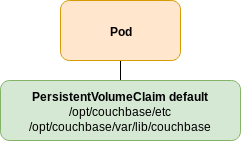Persistent Volumes
The Operator fully supports Couchbase Clusters running with persistent storage. This section details benefits and requirements in order to correctly function.
Benefits of Using Persistent Storage
All production deployments should be run with persistent volumes. At a very basic level this allows us to collect logs and diagnose any Couchbase Server issues. Due to the ephemeral nature of Kubernetes, without persistent volumes those logs would be gone forever in the event of a pod terminally crashing.
Using persistent storage also allows the Couchbase cluster to be tailored to the workload. Persistent volumes allow the selection of storage media type e.g. flash can be explicitly selected for high performance.
Persistent storage also makes the Couchbase cluster far more resilient. In a total disaster an ephemeral cluster cannot be recovered, the data is lost forever. With persistent storage the Operator can recover the cluster.
Recovery is faster with persistent storage. As data is persisted there is a high probability that a large percentage of data is still valid and can be reused. The Operator makes use of delta-node recovery to dramatically reduce rebalance times.
Storage Topologies
The most basic storage topology per node is show below:

This uses the couchbaseclusters.spec.servers.volumeMounts.default volume mount.
The volume has two sub volumes, one for configuration data that must be retained for Couchbase recovery, and one for data and logs.
The Operator additionally allows more advanced configurations as shown below:

Your workload may require high performance disk I/O for data and index services, however configuration and logs may reside on cheaper storage media.
For this reason you can specify couchbaseclusters.spec.servers.volumeMounts.data, couchbaseclusters.spec.servers.volumeMounts.index and couchbaseclusters.spec.servers.volumeMounts.analytics volumes.
Supported Storage Classes
The Operator is designed to work with dynamically provisioned storage classes. While a Couchbase cluster can be configured to use other storage types they are not rigorously tested.
Couchbase Server pods may have different storage volumes associated with each service.
For example couchbaseclusters.spec.servers.volumeMounts.default, which is used for configuration and logging may be on cost effective storage whereas couchbaseclusters.spec.servers.volumeMounts.data may reside on high performance SSD backed storage.
In most cloud providers persistent volumes are scheduled across all possible availability zones. If these two volumes were provisioned in different availability zones then a pod that they were attached to could not be scheduled. Pods must reside in the same availability zone as their storage.
It is for this reason that the Operator requires lazily bound storage classes to function on Kubernetes clusters spread across multiple availability zones. When using lazy binding persistent volumes are not scheduled until after the pod is scheduled. Persistent volumes attached to a pod would then inherit its availability zone and provision correctly.
Please refer to the storage class how-to guide to configure lazy bound storage classes.
|
Some storage providers or platforms may work transparently across availability zones. If this is the case then you may use any existing storage class. Please consult with your Kubernetes vendor to confirm. |
Storage Reclaim Policy
The storage reclaim policy related to a storage class in use by the Operator is largely irrelevant.
The Operator uses PersistentVolumeClaims to keep storage volumes alive.
Our recommendation is to use the Delete policy.
Operator volume names are based on the cluster name, and therefore deleting and recreating a cluster with the same name may alias resource names and cause provisioning failure when a retaining policy is in use.
Using Storage Classes
Couchbase Server pods never run as root. Persistent storage mounts, by default, are mounted as root. This means that Couchbase Server pods are unable to write to the persistent volume.
In order to allow Couchbase Server to write to the persistent storage you must specify a file system group to mount the persistent volume as. This mounts the persistent volume so the Couchbase Server user is able to write to the persistent volume.
The couchbaseclusters.spec.securityContext.fsGroup parameter allows this to be explicitly set.
On Kubernetes the file system group can be any non-zero value (we use 1000 internally for testing).
On Red Hat OpenShift you do not need to populate this field.